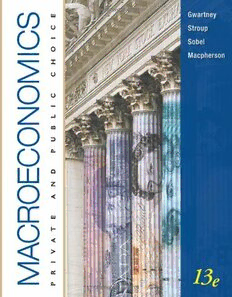Table Of ContentThis page intentionally left blank
The Economics of Input-Output Analysis
Input-outputanalysisisthemaintoolofappliedequilibriumanal-
ysis. This textbook provides a systematic survey of the most
recent developments in input-output analysis and their applica-
tions, helping us to examine questions such as: Which industries
are competitive? What are the multiplier effects of an investment
program? How do environmental restrictions impact on prices?
Linear programming and national accounting are introduced and
usedtoresolveissuessuchasthechoiceoftechnique,thecompar-
ativeadvantageofanationaleconomy,itsefficiencyanddynamic
performance.Technologicalandenvironmentalspilloversareana-
lyzed,atboththenationallevel(betweenindustries)andtheinterna-
tionallevel(themeasurementofglobalizationeffects).Thebookis
self-contained,butassumessomefamiliaritywithcalculus,matrix
algebra,andthemicroeconomicprincipleofoptimizingbehavior.
Exercisesareincludedattheendofeachchapter,andsolutionsat
theendofthebook.
thijs ten raa isAssociateProfessorofEconomicsatTilburg
University.
The Economics of
Input-Output Analysis
THIJS TEN RAA
cambridge university press
Cambridge, New York, Melbourne, Madrid, Cape Town, Singapore, São Paulo
Cambridge University Press
The Edinburgh Building, Cambridge cb2 2ru,UK
Published in the United States of America by Cambridge University Press, New York
www.cambridge.org
Informationo nthi stitle :www.cambri dge.org/9780521841795
©ThijstenRaa2005
This publication is in copyright. Subject to statutory exception and to the provision of
relevant collective licensing agreements, no reproduction of any part may take place
without the written permission of Cambridge University Press.
First published in print format 2006
isbn-13 978-0-511-13982-6 eBook (EBL)
isbn-10 0-511-13982-9
eBook (EBL)
isbn-13 978-0-521-84179-5 hardback
isbn-10 0-521-84179-8 hardback
isbn-13 978-0-521-60267-9 paperback
isbn-10 0-521-60267-x paperback
Cambridge University Press has no responsibility for the persistence or accuracy of urls
for external or third-party internet websites referred to in this publication, and does not
guaranteethatanycontentonsuchwebsitesis,orwillremain,accurateorappropriate.
Contents
List of figures page ix
Listoftables x
Preface xi
Glossary xiii
1 Introduction 1
1.1 Thedefinitionofeconomics 1
1.2 Mathematicalpreliminaries 2
1.3 Constrainedmaximization 4
1.4 Linearanalysis 7
1.5 Input-outputanalysis 11
Exercises 12
References 12
2 Input-outputbasics 14
2.1 Introduction 14
2.2 Pricechanges 17
2.3 Valuerelations 19
2.4 Quantityrelations 22
Exercises 23
References 24
3 Multipliereffects 25
3.1 Introduction 25
3.2 Cost-pushanalysis 25
3.3 Demand-pullanalysis 26
3.4 Consumptioneffects 27
3.5 Employmentmultipliers 30
3.6 Miyazawainverses 34
Exercises 35
References 36
v
vi Contents
4 Linearprogramming 37
4.1 Introduction 37
4.2 Inequalityimplications 37
4.3 Dependentandindependentconstraints 39
4.4 Themaintheorem 41
4.5 Complementaryslackness 43
4.6 Non-degenerateprograms 45
4.7 Activevariables 47
4.8 Marginalproductivityandsensitivity 50
Exercises 52
References 53
5 Areinput-outputcoefficientsfixed? 54
5.1 Introduction 54
5.2 Techniquesandtheroleofdemand 55
5.3 Selectionoftechniques 57
5.4 Thesubstitutiontheorem 60
5.5 Apostscript 63
5.6 Anapplication 63
Exercises 64
References 64
6 TheSystemofNationalAccounts 65
6.1 Introduction 65
6.2 Abird’seyeview 65
6.3 TheSystemofNationalAccounts 67
6.4 Enlargements 71
6.5 Trade 72
6.6 Value-addedtax 77
6.7 Grossnationalproduct 79
6.8 ImputationofVATtoindustries 82
6.9 SocialAccountingMatrices 83
Exercises 84
References 86
7 Theconstructionoftechnicalcoefficients 87
7.1 Introduction 87
7.2 Secondaryproducts 88
7.3 Differentnumbersofcommoditiesandsectors 93
7.4 Otherinputs 96
Exercises 98
References 98
Contents vii
8 Frominput-outputcoefficientstotheCobb–Douglas
function 99
8.1 Introduction 99
8.2 Derivationofthemacroeconomicproductionfunction 100
8.3 Substitution 102
8.4 Returnstoscale 103
Exercises 107
References 107
9 Thediagnosisofinefficiency 108
9.1 Introduction 108
9.2 Inefficiency 108
9.3 Decomposition 112
9.4 DiagnosisoftheCanadianeconomy 114
9.5 DiagnosisoftheDutcheconomy 121
9.6 Robustnessoftheefficiencymeasure 122
Exercises 123
References 123
10 Input-outputanalysisofinternationaltrade 125
10.1 Introduction 125
10.2 Partialequilibriumanalysis 127
10.3 Generalequilibriumanalysis 129
10.4 Thegainstofreetrade 133
10.5 Distortions 136
10.6 Application 137
Exercises 138
References 138
11 Environmentalinput-outputeconomics 139
11.1 Introduction 139
11.2 Standards,taxes,orrightstopollute 139
11.3 Environmentalaccounting 142
11.4 Energypolicy 142
11.5 Pollution 146
11.6 Globalization 149
Exercises 150
References 150
12 Productivitygrowthandspillovers 151
12.1 Introduction 151
12.2 Totalfactorproductivitygrowth 152
viii Contents
12.3 Measurementanddecomposition 154
12.4 ApplicationtotheCanadianeconomy 159
12.5 Internationalspillovers 160
12.6 Intersectoralspillovers 162
12.7 Conclusion 164
Exercise 164
References 164
13 Thedynamicinverse 166
13.1 Introduction 166
13.2 Aone-sectoreconomy 167
13.3 Thematerialbalance 168
13.4 Dynamicinput-outputanalysisofaone-sectoreconomy 169
13.5 Multi-sectoreconomies 171
13.6 Conclusion 174
Exercise 175
References 175
14 Stochasticinput-outputanalysis 176
14.1 Introduction 176
14.2 Stochastics 176
14.3 Application 178
14.4 Conclusion 181
References 182
Solutionstoexercises 183
Index 192

